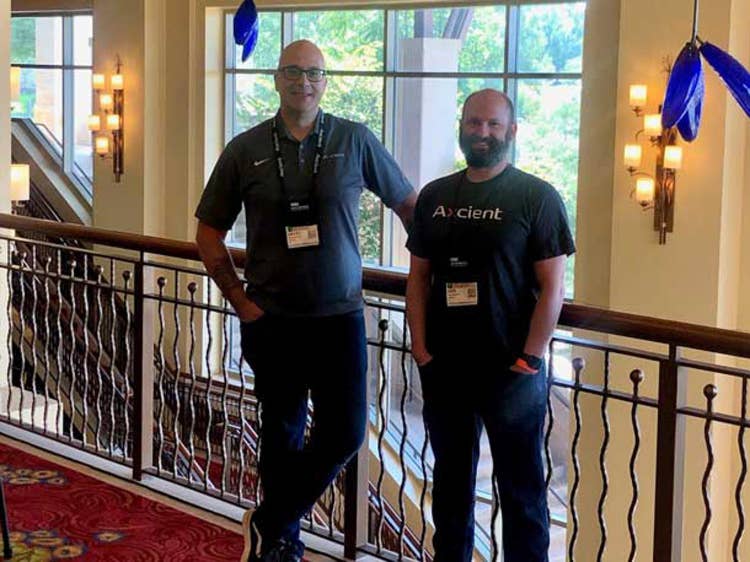Axcient Unveils Local Cache: Fast Data Recovery Alternative To Appliances
‘Before this, an MSP with 50 customers and 100 servers looking to convert to a new business continuity solution would need about six months. We’re seeing partners now convert their entire customer base in 60 days. And that’s the guys who are doing it slow,’ says Axcient’s Ben Nowacky (r.).

Axcient Tuesday at XChange+ 2021 unveiled a local cache addition to its x360Recover Direct to Cloud offering as a way to allow high-speed local recovery in case of a data outage without the need to purchase proprietary local hardware appliances.
The idea behind local cache is to offer businesses the performance of a local data protection caching appliance while giving them the choice to use any hardware including low-cost USB devices to quickly recover in case of data loss, said Ben Nowacky (right, in photo), senior vice president of products for the Denver-based vendor.
Direct to Cloud, or D2C, is based on the same software that powers Axcient’s hardware-based data protection appliances for instant local recovery and virtualization and for providing image-based data protection to the cloud for remote workstations.
[Related: The 20 Coolest Data Protection Companies: The 2021 Storage 100]
“Local cache for Direct to Cloud takes the best of appliance-based backups but eliminates the kludginess and expense,” Nowacky told CRN. “Users can use any device from a USB thumb drive to an extra NAS appliance and still get all the benefits of bare-metal recovery, local virtualization and file folder recovery.”
Direct to Cloud recovers data that was protected by storing copies on a cloud, but recovery depends on how fast a user’s internet connection is, Nowacky said. With local cache, the hottest data can be recovered instantly from the on-premises device, with older data recovered from the cloud, he said.
“It’s important to quickly recover data from the last three to four days,” he said. “But you can go to the cloud for older data.”
Axcient CEO David Bennett (left, in photo) told CRN that when the world was hit by the COVID-19 coronavirus pandemic, he wondered what would happen to backup and disaster recovery if employees couldn’t go back to the office.
“What if there was no more on-premises infrastructure?” Bennett said. “We wanted to offer what clients could get on-prem without the appliance.”
The work-from-home movement increases IT challenges for businesses, Nowacky said.
“IT support is more difficult,” he said. “It gets harder to send replacement gear. If a CEO spills coffee on a PC in the office, it’s easy to fix. Just have the IT person walk over. But if the CEO if remote, it’s not so easy. Axcient’s Recovery Center software in conjunction with local cache lets the CEO connect the USB device to another PC, or virtualize the PC in the cloud.”
Bennett said the CEO spilling coffee on his PC was a true example of what could happen.
“That CEO was me,” he said. “An hour before a remote boardroom presentation, I spilled coffee on my PC. My presentation brought together information from all the board members, but I couldn’t access the data on the PC. But with local cache, I could use another PC and be ready for the meeting.”
Remote work is more than working remotely, Bennett said.
“The security perimeter today is a perimeter of one,” he said. “IT people need to think of workers as individuals in a perimeter of one.”
Solution providers can resell local cache as a way to do endpoint backups without the hassle and cost of other offerings, Bennett said.
“Partners can also easily rip out and replace existing business continuity solutions without the need to replace existing devices,” he said. “This removes the biggest pain point of switching business continuity processes. There’s no more need to bring in a truck to switch the tech.”
Nowacky explained that in this case, local cache can be run together with Direct to Cloud in parallel to a customer’s existing data protection offering, and 30 days later the existing offering can be shut down seamlessly.
“Before this, an MSP with 50 customers and 100 servers looking to convert to a new business continuity solution would need about six months,” he said. “We’re seeing partners now convert their entire customer base in 60 days. And that’s the guys who are doing it slow.”
Axcient has the easiest and simplest way to use business continuity technology, Bennett said.
“It was designed so I would be able to use it, and I’m the dumbest person in the room,” he said.
There is a lot of “shadow IT” where users who don’t get the technology they need purchase it outside their IT departments, thereby opening themselves up to instances of possible compromised data, said Phillip Long, CEO and founder of Business Information Solutions, a Robertsdale, Ala.-based MSP and longtime Axcient channel partner.
“That’s why we jumped in early with Direct to Cloud,” Long told CRN. “Now a user can’t save a file without it being automatically backed up.”
Local cache is a very inexpensive add-on to Direct to Cloud for fast local data recovery, Long said.
“If a client has a data issue, they have a fast local recovery,” said. “I can pick up a file or mount the entire file set and run off it, or can spin it up for a bare-metal restore off the local device. This is an important offering for work-from-home users.”
Local cache is available now, Nowacky said. The bare-metal recovery capability is in preview access now and slated to be in general availability next week, he said.